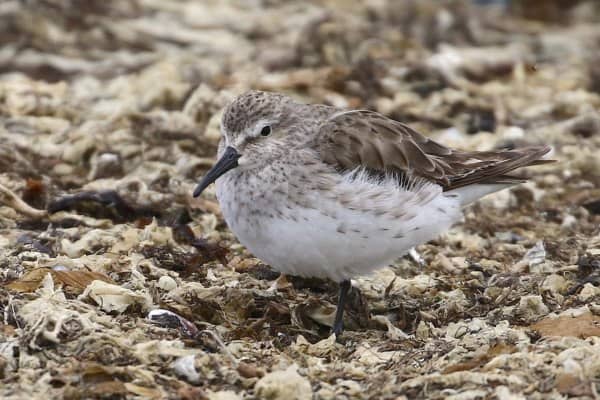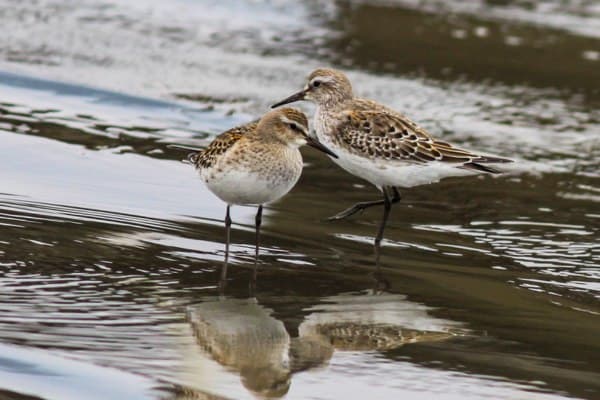Common Name: White-rumped Sandpiper
Scientific Name: (Calidris fuscicollis)| Size | Diet | Range in Hawaii | Status in Hawaii |
|---|---|---|---|
| 6 in. - 7 in. | insects, crustaceans, and mollusks | O'ahu and Maui | Least Concern |
The White-rumped Sandpiper, also known as Calidris fuscicollis, is a small shorebird species that is native to the Arctic regions of North America. While the species is not native to Hawaii, it has been known to make occasional appearances on the islands as a non-breeding visitor and vagrant. With its distinctive appearance and unique foraging behavior, the White-rumped Sandpiper is a fascinating bird species that has captured the attention of birdwatchers and avian enthusiasts around the world.
In this article, we will explore the world of the White-rumped Sandpiper, its unique characteristics, and its occasional presence in Hawaii.
White-rumped Sandpiper
Appearance

The White-rumped Sandpiper is a captivating avian wonder distinguished by its striking appearance. Sporting a compact size of approximately 6 to 7 inches, this petite shorebird boasts a distinctive white rump that beautifully contrasts with its subtly patterned brown plumage.
Diet
As it traverses vast distances during migrations, this petite shorebird relies on a diet primarily composed of small invertebrates. Delicacies such as insects, crustaceans, and mollusks become its main course, plucked skillfully from coastal mudflats and wetlands.
Nesting
Like a tiny artist, the White-rumped Sandpiper intricately selects its nesting sites in the Arctic tundra. With an eye for both safety and proximity to vital food sources, these skilled avian architects craft their nests amidst the low-lying vegetation. Using bits of grass, moss, and even feathers, they mold their homes with a touch of nature’s finesse.
But what truly sets their nesting story apart is their meticulous timing. As the Arctic summer unfurls its brief brilliance, these sandpipers seize the precious window of warmth and plenty. Their nesting season aligns with the peak of insect activity, ensuring a lavish banquet for their growing chicks.
Yet, life in the Arctic is a constant dance with time. The White-rumped Sandpiper knows this all too well. Their chicks hatch in a race against the impending winter, their downy fluff a testament to adaptation.
These chicks must quickly learn to navigate their harsh world and embark on the daunting journey of migration—a testament to the remarkable resilience of these unassuming birds.
Behavior

Picture a shoreline painted with the golden hues of sunrise, where the rhythmic ebb and flow of the tide sets the stage for a stunning spectacle. Here, the White-rumped Sandpiper reveals its true essence as a master of adaptation. As the tide unveils the banquet hidden beneath the sand, these birds engage in an enchanting ballet of foraging.
But it’s not just their dining prowess that makes them fascinating. These sandpipers are also known for their remarkable migrations, traversing awe-inspiring distances with unwavering determination.
From the Arctic tundra, where they breed in fleeting summer, they embark on an epic journey that spans continents. Their migrations take them from the northern reaches of North America to the southern cone of South America, and back again.
Yet, their behavior doesn’t end with their nomadic wanderings. The White-rumped Sandpiper is a social creature, often congregating in flocks that resemble tightly synchronized performances. In these gatherings, their calls and movements create a harmonious symphony, reminding us that unity can be found even among the seemingly transient.
Habitat
The White-rumped Sandpiper finds its enchanting habitat at the nexus of land and water. In the Arctic, it weaves nests amidst tundra vegetation, a fleeting haven of color in the brief summer.
Come winter, these skilled travelers embark on an epic migration, gracing mudflats, marshes, and coastal shores. With delicate steps, they forage for sustenance, embodying adaptability in ever-changing landscapes.
Range

Unveil the enigmatic journey of the White-rumped Sandpiper as a non-breeding visitor to Hawaii. While global sightings span continents, the Hawaiian Islands stand as a unique and substantiated haven, hosting a solitary record near Kahuku, O’ahu, and contemplating a potential sighting on Maui.
Conservation Status
The White-rumped Sandpiper is assessed as “Least Concern” on the IUCN Red List of Threatened Species. This classification suggests that, at that time, the species did not meet the criteria for being classified as threatened or endangered.
Interesting Facts
1. Courtship displays
During the breeding season, male White-rumped Sandpipers engage in elaborate courtship displays to attract females. These displays often involve running, flying, and vocalizations.
2. Nonstop migration
Despite their small size, White-rumped Sandpipers can fly nonstop for incredibly long distances during migration, using their efficient wing design and energy-saving flight techniques.
3. Vocalizations
Their calls are distinct and often heard during their gatherings. Their vocalizations include high-pitched whistles and melodic notes, contributing to the symphony of coastal habitats.
4. Threat response
When sensing danger, White-rumped Sandpipers often adopt a “freeze” behavior, relying on their camouflage to blend in with their surroundings until they perceive the threat has passed.
5. Sexual dimorphism
Male and female White-rumped Sandpipers look alike, making it challenging to distinguish between them based on physical appearance alone. This lack of sexual dimorphism is common among many shorebird species.
Frequently Asked Questions
1. Do White-rumped Sandpipers migrate during the day or night?
White-rumped Sandpipers are diurnal migrants, which means they primarily migrate during the daytime. They take advantage of the sunlight for navigation and feeding opportunities.
2. Do White-rumped Sandpipers make long stops during migration?
Yes, White-rumped Sandpipers make several important stopovers during their migration journey to rest and refuel. These stopover sites are crucial for their successful migration.
3. What is the significance of the White-rumped Sandpiper’s migration in ecosystems?
The White-rumped Sandpiper’s migration contributes to the dispersal of nutrients and aquatic organisms across vast distances, connecting different ecosystems and playing a role in maintaining ecological balance.
4. How can I contribute to White-rumped Sandpiper conservation efforts?
You can contribute by supporting organizations dedicated to bird conservation, spreading awareness about the importance of protecting their habitats, and advocating for policies that prioritize their well-being.
5. What is the average lifespan of a White-rumped Sandpiper in the wild?
The average lifespan of a White-rumped Sandpiper in the wild is around 8 to 10 years. However, various factors such as predation, environmental conditions, and migration challenges can influence individual lifespans.




